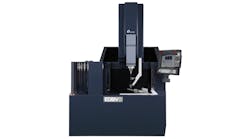For discharge machining of cooling air holes and shaped diffuser holes in blade and vane segments, Makino is introducing the EDBV3 Fast Hole Drill EDM: it indicated the new system will provide aerospace manufacturers with the speed, flexibility, and reliability to produce a range of hole shapes and sizes effectively within a single setup, reducing significantly the variety of tools required and overall cycle times.
“The need for EDM drilling with advanced capabilities in blade and vane components has grown substantially due to new engine production requirements, as aerospace manufacturers strive to improve engine performance and reduce fuel consumption,” according to Makino’s EDM product line manager Brian Pfluger. “The EDBV3 fulfills these needs by building on Makino’s EDM platforms with onboard filtration and resin systems and a user-friendly control system with preprogrammed hole profiles.”
“Its 2-axis rotary table combined with automatic tool and guide change systems enable manufacturers to reliably machine complex features fully unattended, saving time and money, without risk to loss of part quality or accuracy,” he continued.
The EDBV3 is capable of X-, Y- and Z-axis travels of 370 mm, 270 mm and 500 mm (14.5 in., 10.6 in. and 19.6 in.), respectively, and has worktable dimensions of 250 mm by 270 mm, with a maximum workpiece weight load of 5 kg (optional 15-kg payload available.) Its rotary C-Axis head features an EROWA compact chuck that makes possible automatic changing of electrode diameters down to 0.2 mm (0.008 in.), and can spin up to 1,000 rpm.
All EDM drilling on the EDBV3 is performed fully submerged under water for higher part quality, improved stability, and up to 10 times faster processing speeds than conventional technologies. To improve productivity, the EDBV3 uses a single-electrode processing approach that avoids the high cost of custom multi-electrode holders and standardizes the tool holders with a more flexible and cost-efficient system.
Fast, reliable tool and guide systems
For unattended burning of varying cooling hole diameters, the EDBV3 features automatic tool change (ATC) and automatic guide change (AGC) systems. A patented electrode set that combines the electrode holder and die guide together into a common assembly provides enhanced reliability with simple and precise automated exchanges. Together, these features enable 30-second ATC and AGC exchanges.
The EDBV3 uses a rigid guide-arm assembly to hold, locate, and support the die guide, which can be used alternately as a programmable axis (W-axis.) An integrated “middle-guide” system can be applied for small-diameter electrodes, preventing whipping, bending, and vibration. Also, the middle-guide “fingers” retract automatically as the electrode tube reduces in size, using as much of the electrode length as possible.
The standard configuration of the EDBV3 includes a 24-station tool carousel system and 24 holder assemblies to fully tool up the machine. The tool carousel can be exchanged as a palletized magazine for extended hours of automated operation.
Unattended software monitoring
The EDBV3 employs a number of proven software technologies used in Makino’s fine-hole sinker EDM machines. Makino’s Model Plan system is integrated into the controller, providing user-friendly input screens with direct G- and M-code programming formats. An electrode-length management system provides electrode wear tracking, and exchanges electrodes automatically when lengths become too short.
To prevent back-wall impingement during blade and vane cavity wall penetration, the EDBV3 includes a proprietary, and sensitive breakthrough detection circuit. This sensing capability — accomplished while delivering maximum speed and productivity — uses a combination of different adaptive process-monitoring techniques. The machine’s fully submerged processing delivers additional support by allowing debris flushing during breakthrough, for a faster and more stable process.








